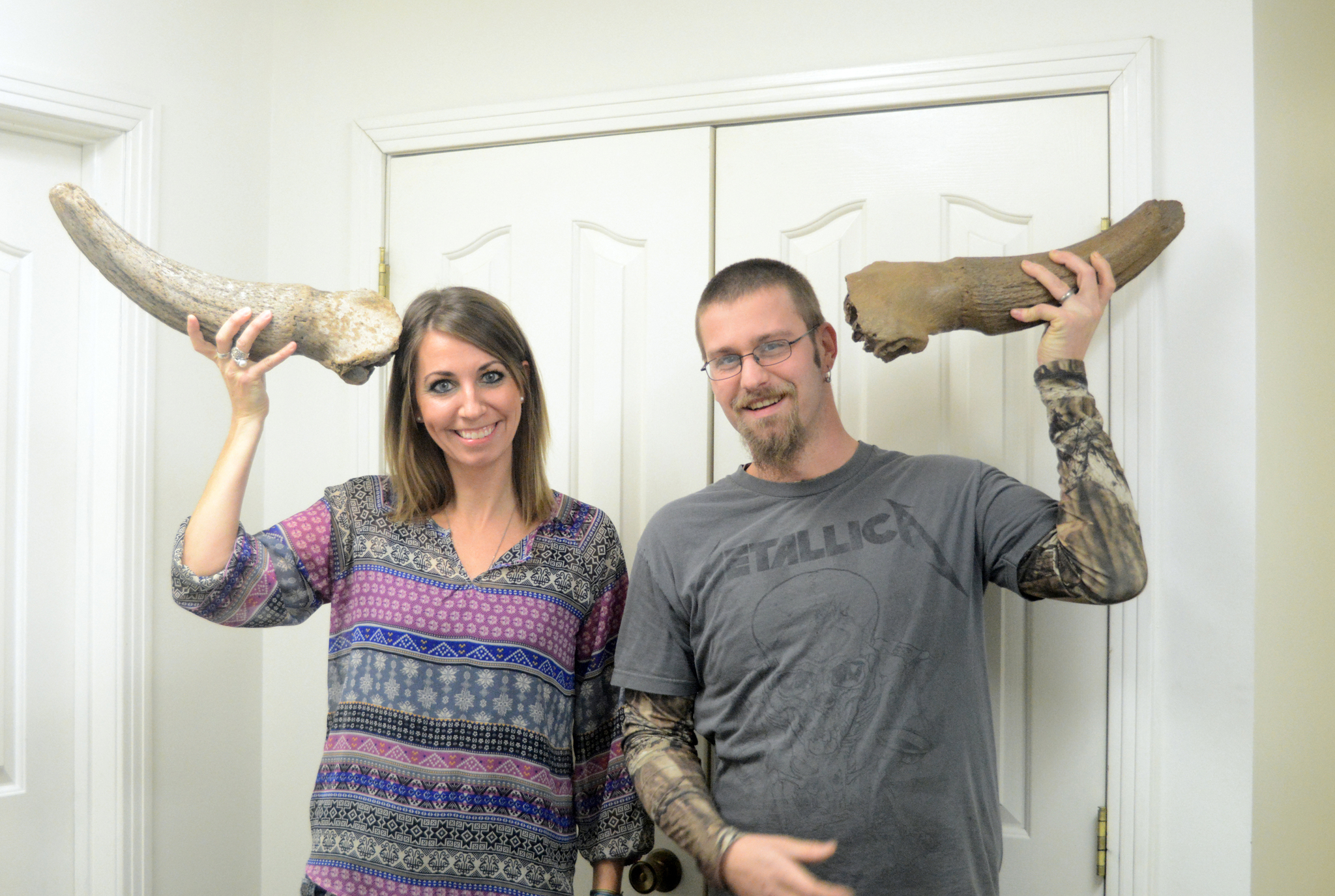On a sunny winter day on Jan. 5, Holly and Jordin Keintz and their daughters Katie and Natalie hiked down to Diamond Creek to enjoy the remote beach at the bottom of a steep trail off the Sterling Highway near Diamond Ridge Road. They didn’t expect to add more information to the story of Ice Age Homer.
About halfway between the bottom of the trail and the mouth of Diamond Creek, Holly Keintz looked down on the rocks and saw “this big chunk,” she said. Jordin said he walked right by it, thinking it a piece of driftwood, but Holly picked it up.
“At first we were thinking it was a walrus tusk, some kind of tooth,” she said.
“It was the biggest dinosaur tooth ever,” Jordin Keintz said, joking.
After doing some Web sleuthing, they realized that “tooth” came from a Pleistocene age mammal, the steppe bison.
“There was one little picture of a steppe bison (on the Web). I was, oh my gosh, that’s a horn,” Holly Keintz said.
More Web searching led them to Janet Klein, a Homer historian who with geologist Dick Reger has been tracking and writing about Pleistocene bones. Last Thursday, Klein met with the Keintzes at the Homer News.
Another Ice Age-bone discoverer, A.J. Weber, dropped by with a steppe bison horn and skull fragment he found while gold panning at Diamond Creek in 2012, just upstream from where Holly Keintz found her bison horn.
Weber and Keintz put their horns side by side on a table. Weber had a left horn and Keintz a right horn. Each measured about 14 inches around at the thickest part. Radiocarbon dating done on Weber’s horn showed it to be at least 43,500 years old.
“I wouldn’t doubt it to be the same one,” Weber said.
Absent skull fragments that could connect the two horns, it would take DNA testing to prove they came from the same animal. But right and left horns about the same size and found nearby suggests that they could be from the same ancient animal that once wandered an ice-free area of the Kenai Peninsula.
Holly Keintz’s find makes the fourth steppe bison bone found in the Diamond Creek area. In 2015, Phil Gordon found the tip of a horn near the mouth of Diamond Creek. Weber found his horn in 2012. In 1948, R.B. Gray, who lived in the Diamond Creek area, found a horn core he gave to the University of Alaska Fairbanks museum.
That brings to 19 the number of Pleistocene bones found between Bishop’s Beach and Clam Gulch. Radiocarbon dates on 12 of the specimens run from 27,000 to 55,000 years ago, an interglacial period called stage 3, between the Penultimate and Naptowne glaciations. Other bones found include horse, woolly mammoth and an unidentified ungulate — moose or caribou — and an unidentified carnivore.
In 2015, Klein and Reger wrote a report for the Alaska Journal of Anthropology, “Late Pleistocene Megafauna, Kenai Peninsula, Southcentral Alaska.” Through analysis of the megafauna finds, Klein and Reger conclude that for at least 28,000 years, mammals persisted on the peninsula before dying out about 20,000 years ago. Large mammals would have lived elsewhere on the Kenai Peninsula during interglacial periods, but later glacial advances would have destroyed their bones.
“We don’t find the remains from Clam Gulch north,” Klein said. “At some point we were a refugium. Dick the geologist said that ice up there ground up everything.”
However, bones deposited in an ice-free zone on the edge of the Diamond Creek drainage and in an ancient lake near Clam Gulch would have survived — some of the bones locals have been finding.
Bones found on or near the beach most likely got washed down from Diamond Creek or other areas. A look up at Homer’s steep bluffs shows a spread of prehistory, with 10-million-year-old coal seams at the bottom and the more recent Pleistocene era at the top. Landslides and storms probably pushed the Pleistocene bones down drainages to the beach. Kachemak Bay’s pounding surf and high tide also rebury the bones.
Many of the bones found have been polished smooth after millennia of beach scouring, although Keintz and Weber’s bison horns don’t show much wear. The Keintzes walked Diamond Creek after a big storm tide, so it’s possible wave action could have recently exposed the bison horn, explaining why it hadn’t been found earlier near a path walked by the hundreds of people who visit the remote beach yearly.
Fossils also could remain in place in the upper drainages, so people digging foundations or outhouse pits might want to keep an eye out for bones.
A photo Jordin took of Holly and their daughter Natalie shows them exclaiming at the find. Excited as they were to find the bone, Jordin said he felt even more awe once they understood what the bone was and how long it had been there.
“It’s like a kid staring into the skies,” Jordin said. “You can’t comprehend it.”
“And yet here it is,” Holly said.
Thinking of the significance of something that old puts humanity’s place on earth in perspective, Jordin said.
“Fifty thousand years ago steppe bison ruled the earth and now mankind is changing the earth,” he said. “One day when we’re gone — I take great peace in this — no matter how we change things, something else will be here after us.”
Klein is always interested in hearing about other finds of possible ancient bones. She can be reached at 907-399-8077.
Michael Armstrong can be reached at michael.armstrong@homernews.com.


